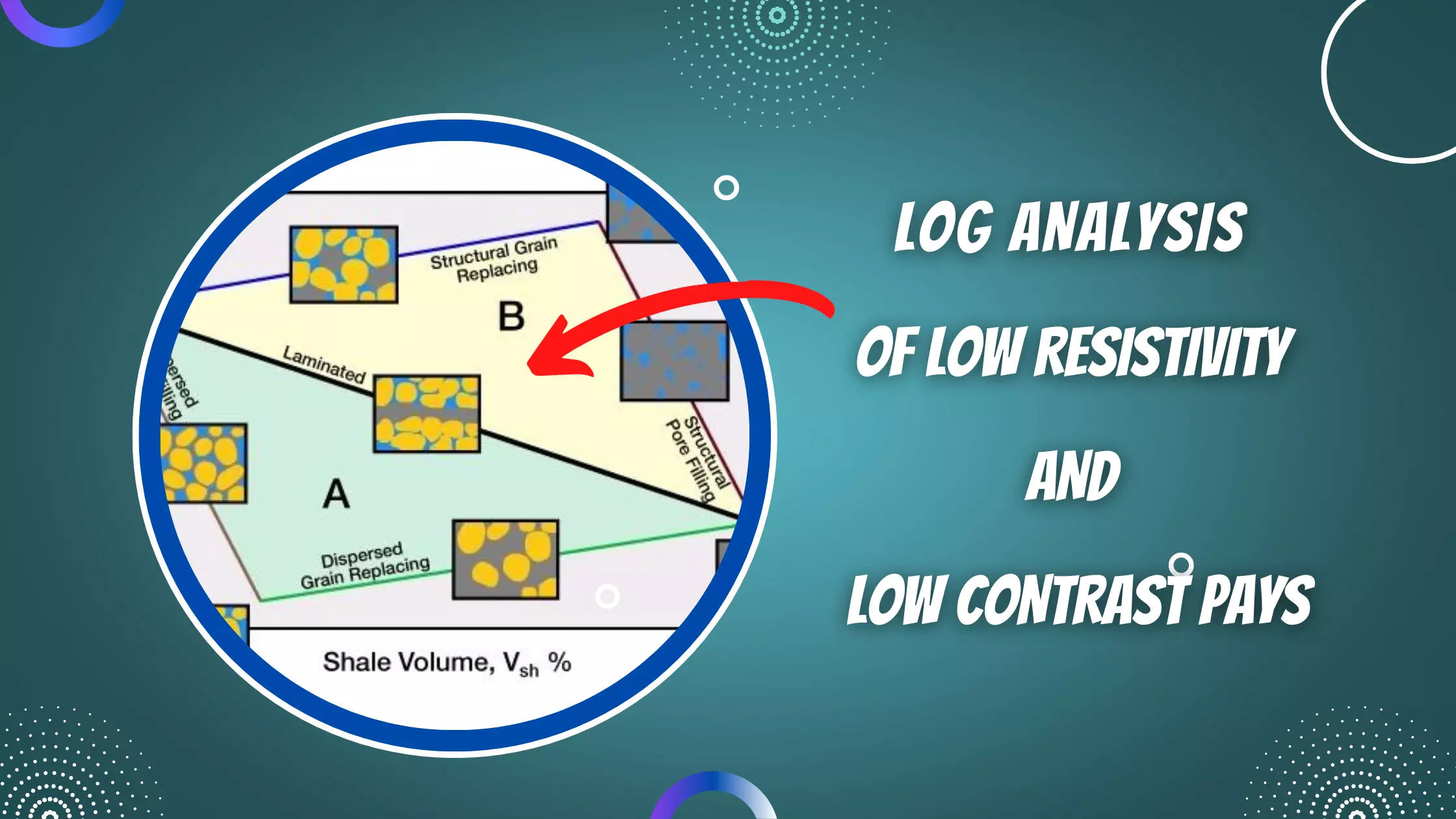Assignment Log Analysis of Low Resistivity and Low Contrast Pays
1. You are a petrophysicist for your company. Describe to your colleagues how you will determine which of the various methods and equations for the well log interpretation of low resistivity and low contrast shaly sandstones will be used for various shale distribution models.
Solution
- When the clay and shale is dispersed, or when the clay or shale distribution is unknown, either the dispersed clay or the Fertl method and equations will be used.
- If the shale is laminated, then either the Simandoux or the dual water method and equations will be used.
- When the clay is dispersed and the resistivity of the dispersed clay is known to be the same as the adjacent shale, such as in bioturbated or turbidite shaly sandstones, either the Simandoux or dual water method and equations will be used.
- If the resistivity of the dispersed clay in the shaly sandstone is known, then either the Simandoux or dual water method and equations will be used.
- In areas where formation water resistivities are high (Rw > 0.1 ohm-m), water saturations calculated by the Fertl and the dispersed clay methods should be used with caution, because it is assumed in both equations that Rsh > Rw; however, in shaly sands with high formation water resistivities, this assumption may not be true. If Rsh ≅ Rw, use the dual water method.
- When cation exchange capacity data is available, use the Waxman-Smits-Thomas method, irrespective of the shale distribution type.
2. State the Archie equation, which is used to determine the water saturation, Sw, of clean sandstones, in terms of the formation factor (F), the saturation exponent (n), the formation water resistivity (Rw), and the true formation resistivity (Rt) of the uninvaded formation. Also express the formation factor (F) in terms of the parameters a (tortuosity factor) and m (cementation exponent), and the porosity.
Solution
![]()
3. As a petrophysicist, describe to your colleagues the basic principles of the dual water well log interpretation model.
Solution
The dual water model for determining a formation’s water saturation separates the pore water into bound water and free water, each of which contributes to the resistivity of the shaly sandstone. The bound water and the free water have their own associated resistivities, Rb and Rw respectively. In this model, Rb is fresher than Rw, which can move freely within the pores.
Assessment Log Analysis of Low Resistivity and Low Contrast Pays
1. Which of the following common constituents of shaly sandstones have high cation exchange capacities? (Select all that apply.)
A .Illite
B .Montmorillonite
C .Feldspar
D .Quartz
2. Which petrophysical parameters should always be determined by special core analysis of the specific reservoir formation being evaluated for high quality petrophysical interpretations? (Select all that apply.)
A .a
B .n
C .![]()
D .m
3. How can petrophysical parameters, such as the cementation factor m, be determined? (Select all that apply.)
A .Differentiation
B .Full diameter core analysis
C .Crossplots
D .Pickett plot
4. What is the term for the SP reading in a thick, clean sandstone?
A .Thick spontaneous potential (TSP)
B .Pseudo-static spontaneous potential (PSP)
C .Clean spontaneous potential (CSP)
D .Static spontaneous potential (SSP)
5. Which of the following minerals are usually radioactive? (Select all that apply.)
A .Albite feldspar
B .Anorthite feldspar
C .Clay minerals
D .Potassium feldspar
6. Which of the following effects do clay and shale generally have on well log data? (Select all that apply.)
A .Density porosity values read too high.
B .Neutron porosity values read too high.
C .Sonic or acoustic porosity values read too high.
D .Resistivity values read too high.
7. In log analysis, the letter “F” stands for which term?
A .Formation factor
B .Finite difference
C .Full waveform
D .Focused log
8. Which method of determining the water saturation requires cation exchange capacity (CEC) data?
A .Dual water
B .Indonesia
C .Waxman-Smits
D .Fertl
9. Which of the following equations can be used to determine the shale volume from the gamma ray? (Select all that apply.)
A .Bateman
B .Linear
C .Clavier
D .Fetkovich
10. What is the primary cause of low resistivity pay?
A .Bound water
B .Tight sandstone
C .Fresh water drilling mud
D .Carbonate formations
11. If several shale volume indicators are used, how is the correct value of Vsh best determined?
A .The highest of all the indicators
B .Geometric average of the indicators
C .Arithmetic average of the indicators
D .The lowest of all the indicators
12. In which situation is the basic Archie equation still usable for calculating the water saturation?
A .Low resistivity pay zones
B .Thick, clean reservoirs
C .Thinly laminated, shaly sandstones
D .Shaly dolomite reservoirs
13. Which of the following researchers have given their name to an equation for determining the water saturation of shaly sandstones? (Select all that apply.)
A .Poupon
B .Knight
C .Clavier
D .Simandoux
14. In which conditions should the density-neutron log not be used for determining the shale volume, Vsh?
A .It can always be used
B .When oil base drilling mud has been used
C .When the shaly sandstone is gas bearing
D .In unconsolidated formations
Recommended for You
Historical and Geological Perspective of Low Resistivity and Low Contrast Pay
Clays, Shales and Non-Clay Contributors to Low Resistivity
Cation Exchange Capacity and Irreducible Water Saturation
Logging Tools For Evaluating Low Resistivity And Low Contrast Pay
 Petro Shine The Place for Oil and Gas Professionals.
Petro Shine The Place for Oil and Gas Professionals.




